აზიური ფაროსანას წინააღმდეგ მავნე ორგანიზმების ინტეგრირებული მართვის ქართული მოდელი, როგორც რეგიონული რეაგირება გლობალურ სასოფლო-სამეურნეო საფრთხეზე
Main Article Content
ანოტაცია
აზიური ფაროსანა (Halyomorpha halys) საქართველოში ერთ-ერთ ყველაზე დამაზიანებელ ინვაზიურ
მავნებელს წარმოადგენს (2016 წლიდან), რომელიც სერიოზულ ზიანს აყენებს სასოფლო-სამეურნეო კულტურებს,
თხილს, თესლოვან და კურკოვან ხეხილს, სიმინდს და სხვ. ამ საფრთხის შესამცირებლად დასავლეთ საქართველოს
ყველაზე დაზარალებულ რეგიონებში შემუშავდა და განხორციელდა რეგიონულ პირობებზე მორგებული მავნე
ორგანიზმების ინტეგრირებული მართვის (IPM) მოდელი. წარმოდგენილი კვლევა აფასებს IPM სტრატეგიის
ეფექტიანობას, რომელიც მოიცავდა ფერომონიანი დამჭერებით მავნებლის მონიტორინგს, ეფექტური
ინსექტიციდებით მიზნობრივ დამუშავებას, ბიოლოგიური კონტროლის საველე ექსპერიმენტებს Trissolcus grandis-ის
გამოყენებით და მოსახლეობის ცნობიერების ამაღლებას მათი ჩართულობის მიზნით. 2017–2024 წლებში,
მონიტორინგისათვის ყოველწლიურად გამოიყენება 7000-ზე მეტი ფერომონიანი დამჭერი, რაც უზრუნველყოფდა
რეალურ დროში მონაცემებზე დაფუძნებულ ღონისძიებების გატარებას და ამცირებდა ქიმიური პრეპარატების
არამიზნობრივ გამოყენებას. მიღებულმა შედეგებმა ცხადყო H. halys-ის პოპულაციის მკვეთრი შემცირება და
მოსავლის დანაკარგების მნიშვნელოვანი კლება. კოორდინირებულმა IPM მიდგომამ დაამტკიცა თავისი ეფექტიანობა
და მასშტაბურობა, რაც შესაძლებელს ხდის ინვაზიური მავნებლების მართვისთვის მსგავსი აგროწარმოებითი
პირობების ფარგლებში გამოყენებულ იქნას სხვა რეგიონებშიც.
